Repairing Plasma Membrane, Energy Metabolism, and Cellular Organelles
VerifiedAdded on 2019/09/30
|6
|2151
|51
Report
AI Summary
The assignment content discusses various organelles present in a cell. It highlights the importance of lysosomes, which have enzymes capable of digesting unused materials within the cytoplasm. The endoplasmic reticulum and Golgi apparatus are also mentioned, playing roles in synthesizing and importing enzymes respectively. The ribosome is another crucial organelle responsible for protein synthesis through RNA molecules. Additionally, the assignment covers the structure of the cell membrane, including proteins, glycolipids, phospholipid bilayer, and glycoproteins, which play important functions such as facilitating diffusion, osmosis, and active transport. The text concludes by emphasizing the significance of the structure of the cell in overall bodily functions.
Contribute Materials
Your contribution can guide someone’s learning journey. Share your
documents today.
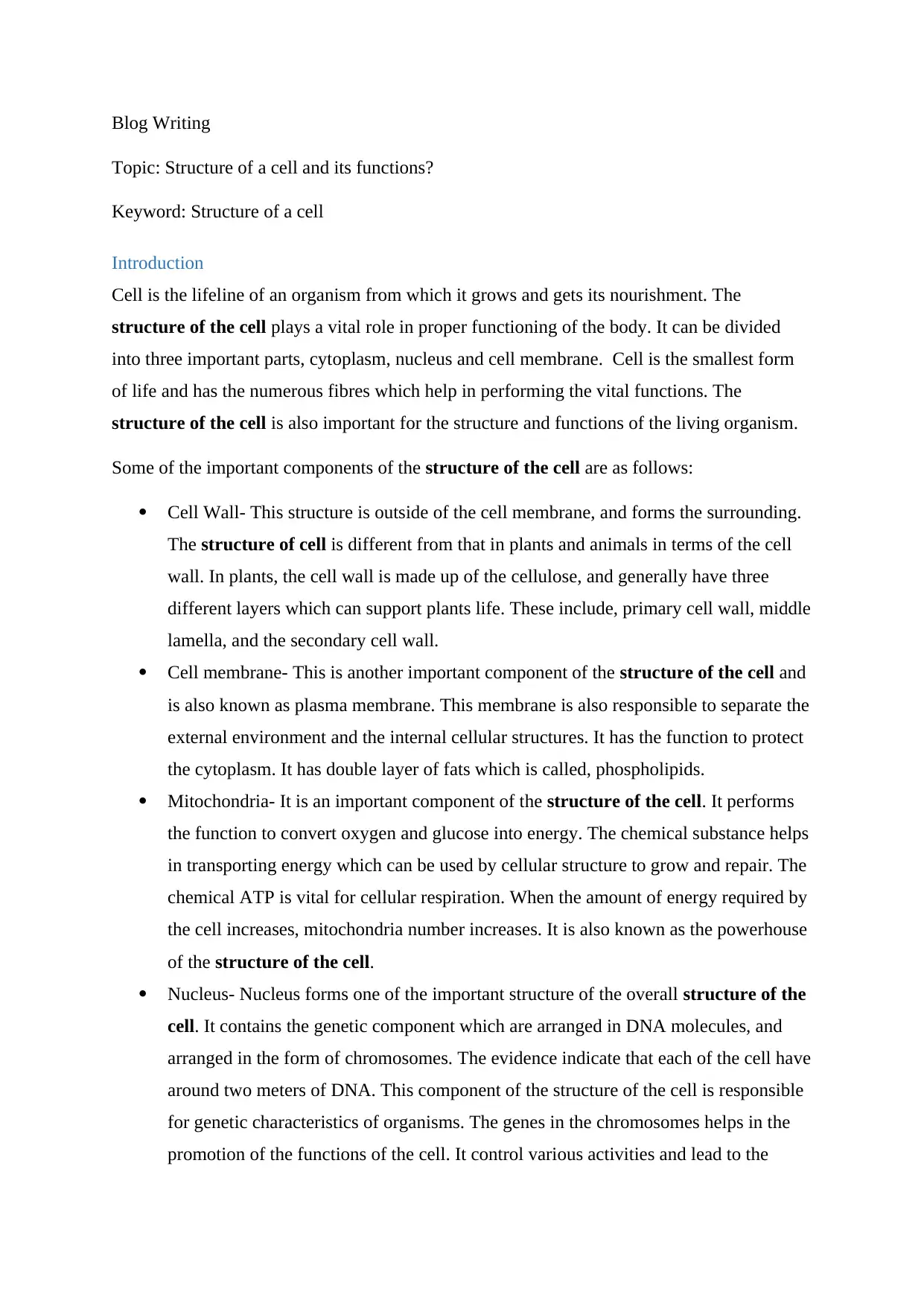
Blog Writing
Topic: Structure of a cell and its functions?
Keyword: Structure of a cell
Introduction
Cell is the lifeline of an organism from which it grows and gets its nourishment. The
structure of the cell plays a vital role in proper functioning of the body. It can be divided
into three important parts, cytoplasm, nucleus and cell membrane. Cell is the smallest form
of life and has the numerous fibres which help in performing the vital functions. The
structure of the cell is also important for the structure and functions of the living organism.
Some of the important components of the structure of the cell are as follows:
Cell Wall- This structure is outside of the cell membrane, and forms the surrounding.
The structure of cell is different from that in plants and animals in terms of the cell
wall. In plants, the cell wall is made up of the cellulose, and generally have three
different layers which can support plants life. These include, primary cell wall, middle
lamella, and the secondary cell wall.
Cell membrane- This is another important component of the structure of the cell and
is also known as plasma membrane. This membrane is also responsible to separate the
external environment and the internal cellular structures. It has the function to protect
the cytoplasm. It has double layer of fats which is called, phospholipids.
Mitochondria- It is an important component of the structure of the cell. It performs
the function to convert oxygen and glucose into energy. The chemical substance helps
in transporting energy which can be used by cellular structure to grow and repair. The
chemical ATP is vital for cellular respiration. When the amount of energy required by
the cell increases, mitochondria number increases. It is also known as the powerhouse
of the structure of the cell.
Nucleus- Nucleus forms one of the important structure of the overall structure of the
cell. It contains the genetic component which are arranged in DNA molecules, and
arranged in the form of chromosomes. The evidence indicate that each of the cell have
around two meters of DNA. This component of the structure of the cell is responsible
for genetic characteristics of organisms. The genes in the chromosomes helps in the
promotion of the functions of the cell. It control various activities and lead to the
Topic: Structure of a cell and its functions?
Keyword: Structure of a cell
Introduction
Cell is the lifeline of an organism from which it grows and gets its nourishment. The
structure of the cell plays a vital role in proper functioning of the body. It can be divided
into three important parts, cytoplasm, nucleus and cell membrane. Cell is the smallest form
of life and has the numerous fibres which help in performing the vital functions. The
structure of the cell is also important for the structure and functions of the living organism.
Some of the important components of the structure of the cell are as follows:
Cell Wall- This structure is outside of the cell membrane, and forms the surrounding.
The structure of cell is different from that in plants and animals in terms of the cell
wall. In plants, the cell wall is made up of the cellulose, and generally have three
different layers which can support plants life. These include, primary cell wall, middle
lamella, and the secondary cell wall.
Cell membrane- This is another important component of the structure of the cell and
is also known as plasma membrane. This membrane is also responsible to separate the
external environment and the internal cellular structures. It has the function to protect
the cytoplasm. It has double layer of fats which is called, phospholipids.
Mitochondria- It is an important component of the structure of the cell. It performs
the function to convert oxygen and glucose into energy. The chemical substance helps
in transporting energy which can be used by cellular structure to grow and repair. The
chemical ATP is vital for cellular respiration. When the amount of energy required by
the cell increases, mitochondria number increases. It is also known as the powerhouse
of the structure of the cell.
Nucleus- Nucleus forms one of the important structure of the overall structure of the
cell. It contains the genetic component which are arranged in DNA molecules, and
arranged in the form of chromosomes. The evidence indicate that each of the cell have
around two meters of DNA. This component of the structure of the cell is responsible
for genetic characteristics of organisms. The genes in the chromosomes helps in the
promotion of the functions of the cell. It control various activities and lead to the
Secure Best Marks with AI Grader
Need help grading? Try our AI Grader for instant feedback on your assignments.
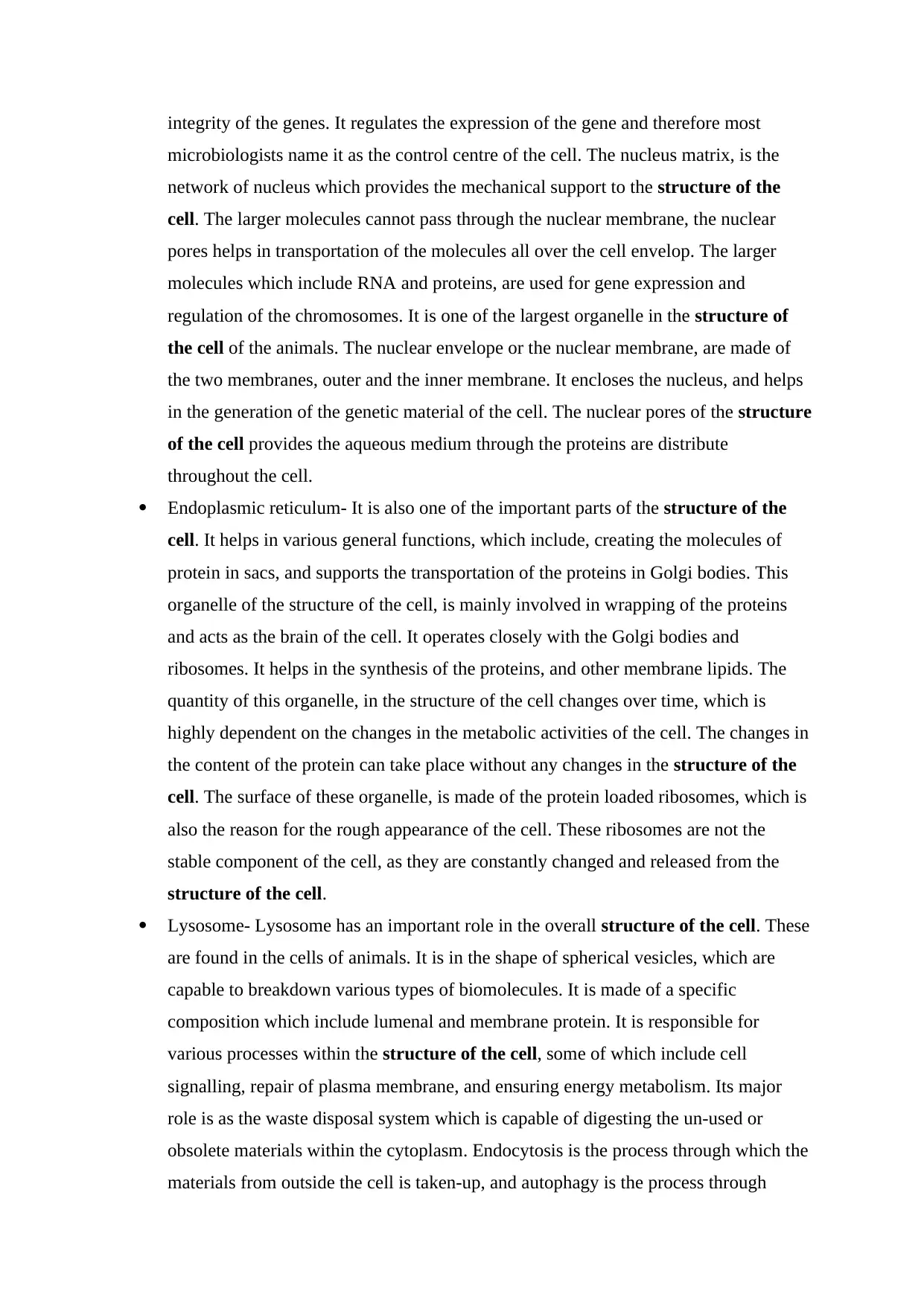
integrity of the genes. It regulates the expression of the gene and therefore most
microbiologists name it as the control centre of the cell. The nucleus matrix, is the
network of nucleus which provides the mechanical support to the structure of the
cell. The larger molecules cannot pass through the nuclear membrane, the nuclear
pores helps in transportation of the molecules all over the cell envelop. The larger
molecules which include RNA and proteins, are used for gene expression and
regulation of the chromosomes. It is one of the largest organelle in the structure of
the cell of the animals. The nuclear envelope or the nuclear membrane, are made of
the two membranes, outer and the inner membrane. It encloses the nucleus, and helps
in the generation of the genetic material of the cell. The nuclear pores of the structure
of the cell provides the aqueous medium through the proteins are distribute
throughout the cell.
Endoplasmic reticulum- It is also one of the important parts of the structure of the
cell. It helps in various general functions, which include, creating the molecules of
protein in sacs, and supports the transportation of the proteins in Golgi bodies. This
organelle of the structure of the cell, is mainly involved in wrapping of the proteins
and acts as the brain of the cell. It operates closely with the Golgi bodies and
ribosomes. It helps in the synthesis of the proteins, and other membrane lipids. The
quantity of this organelle, in the structure of the cell changes over time, which is
highly dependent on the changes in the metabolic activities of the cell. The changes in
the content of the protein can take place without any changes in the structure of the
cell. The surface of these organelle, is made of the protein loaded ribosomes, which is
also the reason for the rough appearance of the cell. These ribosomes are not the
stable component of the cell, as they are constantly changed and released from the
structure of the cell.
Lysosome- Lysosome has an important role in the overall structure of the cell. These
are found in the cells of animals. It is in the shape of spherical vesicles, which are
capable to breakdown various types of biomolecules. It is made of a specific
composition which include lumenal and membrane protein. It is responsible for
various processes within the structure of the cell, some of which include cell
signalling, repair of plasma membrane, and ensuring energy metabolism. Its major
role is as the waste disposal system which is capable of digesting the un-used or
obsolete materials within the cytoplasm. Endocytosis is the process through which the
materials from outside the cell is taken-up, and autophagy is the process through
microbiologists name it as the control centre of the cell. The nucleus matrix, is the
network of nucleus which provides the mechanical support to the structure of the
cell. The larger molecules cannot pass through the nuclear membrane, the nuclear
pores helps in transportation of the molecules all over the cell envelop. The larger
molecules which include RNA and proteins, are used for gene expression and
regulation of the chromosomes. It is one of the largest organelle in the structure of
the cell of the animals. The nuclear envelope or the nuclear membrane, are made of
the two membranes, outer and the inner membrane. It encloses the nucleus, and helps
in the generation of the genetic material of the cell. The nuclear pores of the structure
of the cell provides the aqueous medium through the proteins are distribute
throughout the cell.
Endoplasmic reticulum- It is also one of the important parts of the structure of the
cell. It helps in various general functions, which include, creating the molecules of
protein in sacs, and supports the transportation of the proteins in Golgi bodies. This
organelle of the structure of the cell, is mainly involved in wrapping of the proteins
and acts as the brain of the cell. It operates closely with the Golgi bodies and
ribosomes. It helps in the synthesis of the proteins, and other membrane lipids. The
quantity of this organelle, in the structure of the cell changes over time, which is
highly dependent on the changes in the metabolic activities of the cell. The changes in
the content of the protein can take place without any changes in the structure of the
cell. The surface of these organelle, is made of the protein loaded ribosomes, which is
also the reason for the rough appearance of the cell. These ribosomes are not the
stable component of the cell, as they are constantly changed and released from the
structure of the cell.
Lysosome- Lysosome has an important role in the overall structure of the cell. These
are found in the cells of animals. It is in the shape of spherical vesicles, which are
capable to breakdown various types of biomolecules. It is made of a specific
composition which include lumenal and membrane protein. It is responsible for
various processes within the structure of the cell, some of which include cell
signalling, repair of plasma membrane, and ensuring energy metabolism. Its major
role is as the waste disposal system which is capable of digesting the un-used or
obsolete materials within the cytoplasm. Endocytosis is the process through which the
materials from outside the cell is taken-up, and autophagy is the process through
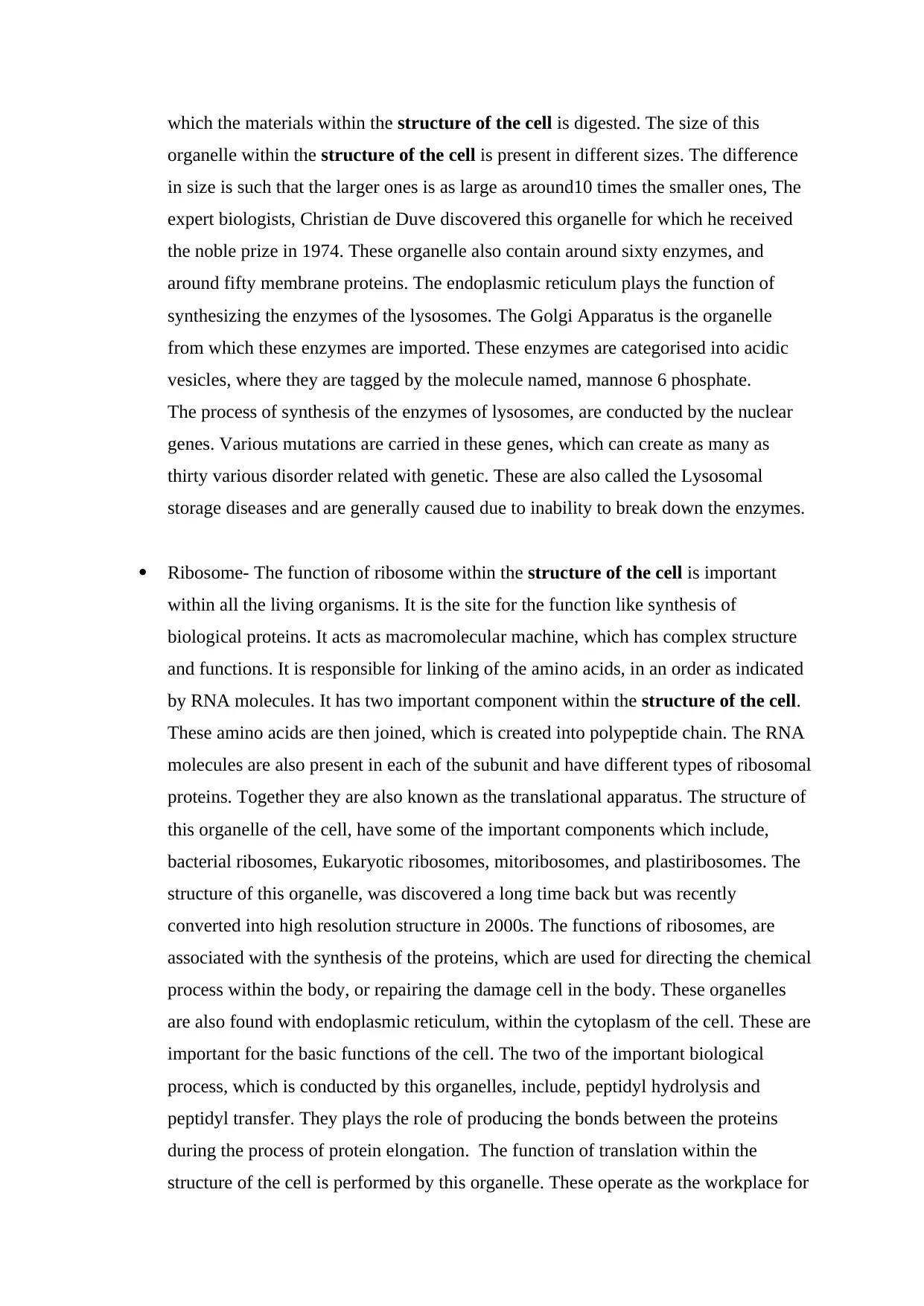
which the materials within the structure of the cell is digested. The size of this
organelle within the structure of the cell is present in different sizes. The difference
in size is such that the larger ones is as large as around10 times the smaller ones, The
expert biologists, Christian de Duve discovered this organelle for which he received
the noble prize in 1974. These organelle also contain around sixty enzymes, and
around fifty membrane proteins. The endoplasmic reticulum plays the function of
synthesizing the enzymes of the lysosomes. The Golgi Apparatus is the organelle
from which these enzymes are imported. These enzymes are categorised into acidic
vesicles, where they are tagged by the molecule named, mannose 6 phosphate.
The process of synthesis of the enzymes of lysosomes, are conducted by the nuclear
genes. Various mutations are carried in these genes, which can create as many as
thirty various disorder related with genetic. These are also called the Lysosomal
storage diseases and are generally caused due to inability to break down the enzymes.
Ribosome- The function of ribosome within the structure of the cell is important
within all the living organisms. It is the site for the function like synthesis of
biological proteins. It acts as macromolecular machine, which has complex structure
and functions. It is responsible for linking of the amino acids, in an order as indicated
by RNA molecules. It has two important component within the structure of the cell.
These amino acids are then joined, which is created into polypeptide chain. The RNA
molecules are also present in each of the subunit and have different types of ribosomal
proteins. Together they are also known as the translational apparatus. The structure of
this organelle of the cell, have some of the important components which include,
bacterial ribosomes, Eukaryotic ribosomes, mitoribosomes, and plastiribosomes. The
structure of this organelle, was discovered a long time back but was recently
converted into high resolution structure in 2000s. The functions of ribosomes, are
associated with the synthesis of the proteins, which are used for directing the chemical
process within the body, or repairing the damage cell in the body. These organelles
are also found with endoplasmic reticulum, within the cytoplasm of the cell. These are
important for the basic functions of the cell. The two of the important biological
process, which is conducted by this organelles, include, peptidyl hydrolysis and
peptidyl transfer. They plays the role of producing the bonds between the proteins
during the process of protein elongation. The function of translation within the
structure of the cell is performed by this organelle. These operate as the workplace for
organelle within the structure of the cell is present in different sizes. The difference
in size is such that the larger ones is as large as around10 times the smaller ones, The
expert biologists, Christian de Duve discovered this organelle for which he received
the noble prize in 1974. These organelle also contain around sixty enzymes, and
around fifty membrane proteins. The endoplasmic reticulum plays the function of
synthesizing the enzymes of the lysosomes. The Golgi Apparatus is the organelle
from which these enzymes are imported. These enzymes are categorised into acidic
vesicles, where they are tagged by the molecule named, mannose 6 phosphate.
The process of synthesis of the enzymes of lysosomes, are conducted by the nuclear
genes. Various mutations are carried in these genes, which can create as many as
thirty various disorder related with genetic. These are also called the Lysosomal
storage diseases and are generally caused due to inability to break down the enzymes.
Ribosome- The function of ribosome within the structure of the cell is important
within all the living organisms. It is the site for the function like synthesis of
biological proteins. It acts as macromolecular machine, which has complex structure
and functions. It is responsible for linking of the amino acids, in an order as indicated
by RNA molecules. It has two important component within the structure of the cell.
These amino acids are then joined, which is created into polypeptide chain. The RNA
molecules are also present in each of the subunit and have different types of ribosomal
proteins. Together they are also known as the translational apparatus. The structure of
this organelle of the cell, have some of the important components which include,
bacterial ribosomes, Eukaryotic ribosomes, mitoribosomes, and plastiribosomes. The
structure of this organelle, was discovered a long time back but was recently
converted into high resolution structure in 2000s. The functions of ribosomes, are
associated with the synthesis of the proteins, which are used for directing the chemical
process within the body, or repairing the damage cell in the body. These organelles
are also found with endoplasmic reticulum, within the cytoplasm of the cell. These are
important for the basic functions of the cell. The two of the important biological
process, which is conducted by this organelles, include, peptidyl hydrolysis and
peptidyl transfer. They plays the role of producing the bonds between the proteins
during the process of protein elongation. The function of translation within the
structure of the cell is performed by this organelle. These operate as the workplace for
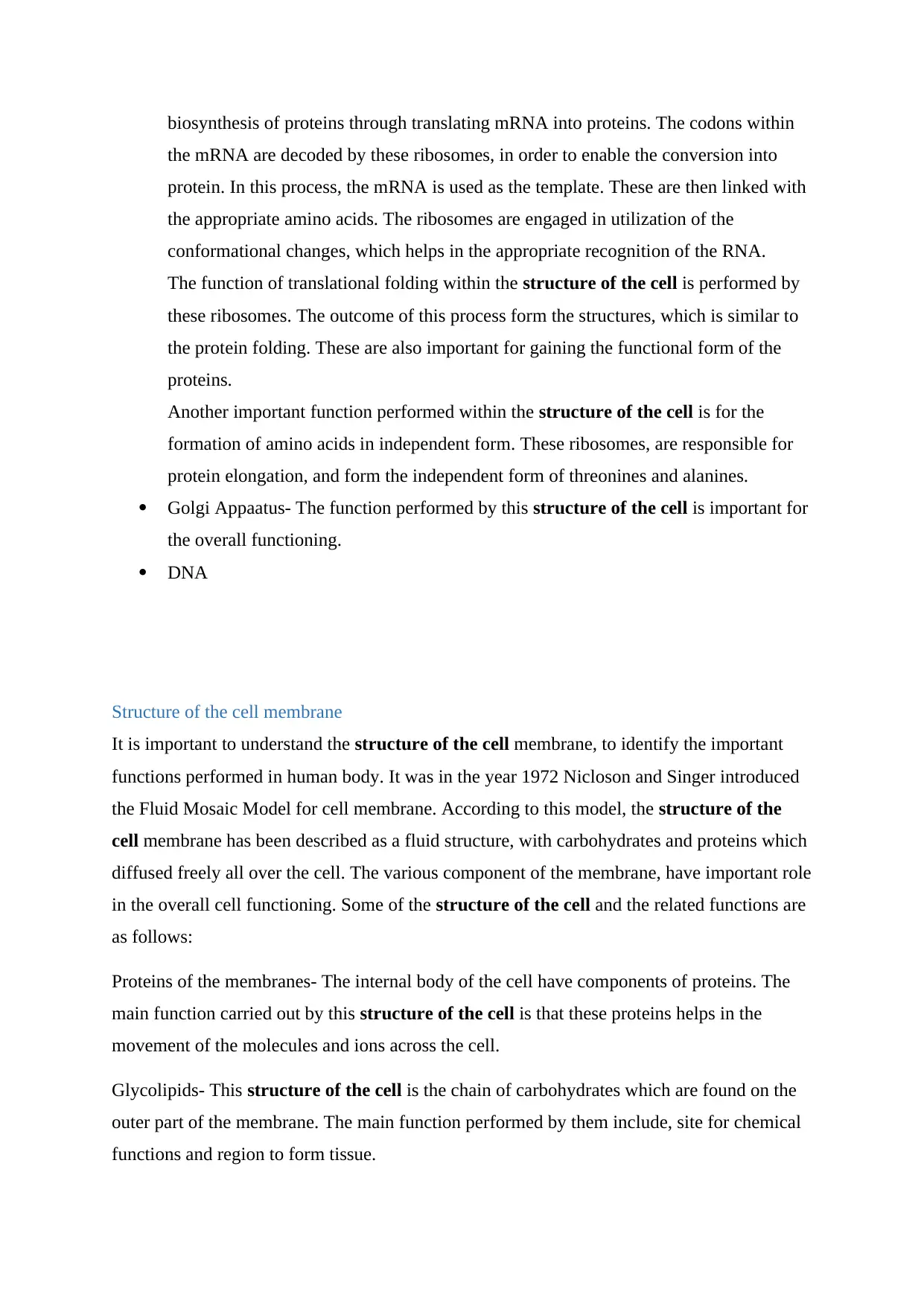
biosynthesis of proteins through translating mRNA into proteins. The codons within
the mRNA are decoded by these ribosomes, in order to enable the conversion into
protein. In this process, the mRNA is used as the template. These are then linked with
the appropriate amino acids. The ribosomes are engaged in utilization of the
conformational changes, which helps in the appropriate recognition of the RNA.
The function of translational folding within the structure of the cell is performed by
these ribosomes. The outcome of this process form the structures, which is similar to
the protein folding. These are also important for gaining the functional form of the
proteins.
Another important function performed within the structure of the cell is for the
formation of amino acids in independent form. These ribosomes, are responsible for
protein elongation, and form the independent form of threonines and alanines.
Golgi Appaatus- The function performed by this structure of the cell is important for
the overall functioning.
DNA
Structure of the cell membrane
It is important to understand the structure of the cell membrane, to identify the important
functions performed in human body. It was in the year 1972 Nicloson and Singer introduced
the Fluid Mosaic Model for cell membrane. According to this model, the structure of the
cell membrane has been described as a fluid structure, with carbohydrates and proteins which
diffused freely all over the cell. The various component of the membrane, have important role
in the overall cell functioning. Some of the structure of the cell and the related functions are
as follows:
Proteins of the membranes- The internal body of the cell have components of proteins. The
main function carried out by this structure of the cell is that these proteins helps in the
movement of the molecules and ions across the cell.
Glycolipids- This structure of the cell is the chain of carbohydrates which are found on the
outer part of the membrane. The main function performed by them include, site for chemical
functions and region to form tissue.
the mRNA are decoded by these ribosomes, in order to enable the conversion into
protein. In this process, the mRNA is used as the template. These are then linked with
the appropriate amino acids. The ribosomes are engaged in utilization of the
conformational changes, which helps in the appropriate recognition of the RNA.
The function of translational folding within the structure of the cell is performed by
these ribosomes. The outcome of this process form the structures, which is similar to
the protein folding. These are also important for gaining the functional form of the
proteins.
Another important function performed within the structure of the cell is for the
formation of amino acids in independent form. These ribosomes, are responsible for
protein elongation, and form the independent form of threonines and alanines.
Golgi Appaatus- The function performed by this structure of the cell is important for
the overall functioning.
DNA
Structure of the cell membrane
It is important to understand the structure of the cell membrane, to identify the important
functions performed in human body. It was in the year 1972 Nicloson and Singer introduced
the Fluid Mosaic Model for cell membrane. According to this model, the structure of the
cell membrane has been described as a fluid structure, with carbohydrates and proteins which
diffused freely all over the cell. The various component of the membrane, have important role
in the overall cell functioning. Some of the structure of the cell and the related functions are
as follows:
Proteins of the membranes- The internal body of the cell have components of proteins. The
main function carried out by this structure of the cell is that these proteins helps in the
movement of the molecules and ions across the cell.
Glycolipids- This structure of the cell is the chain of carbohydrates which are found on the
outer part of the membrane. The main function performed by them include, site for chemical
functions and region to form tissue.
Secure Best Marks with AI Grader
Need help grading? Try our AI Grader for instant feedback on your assignments.
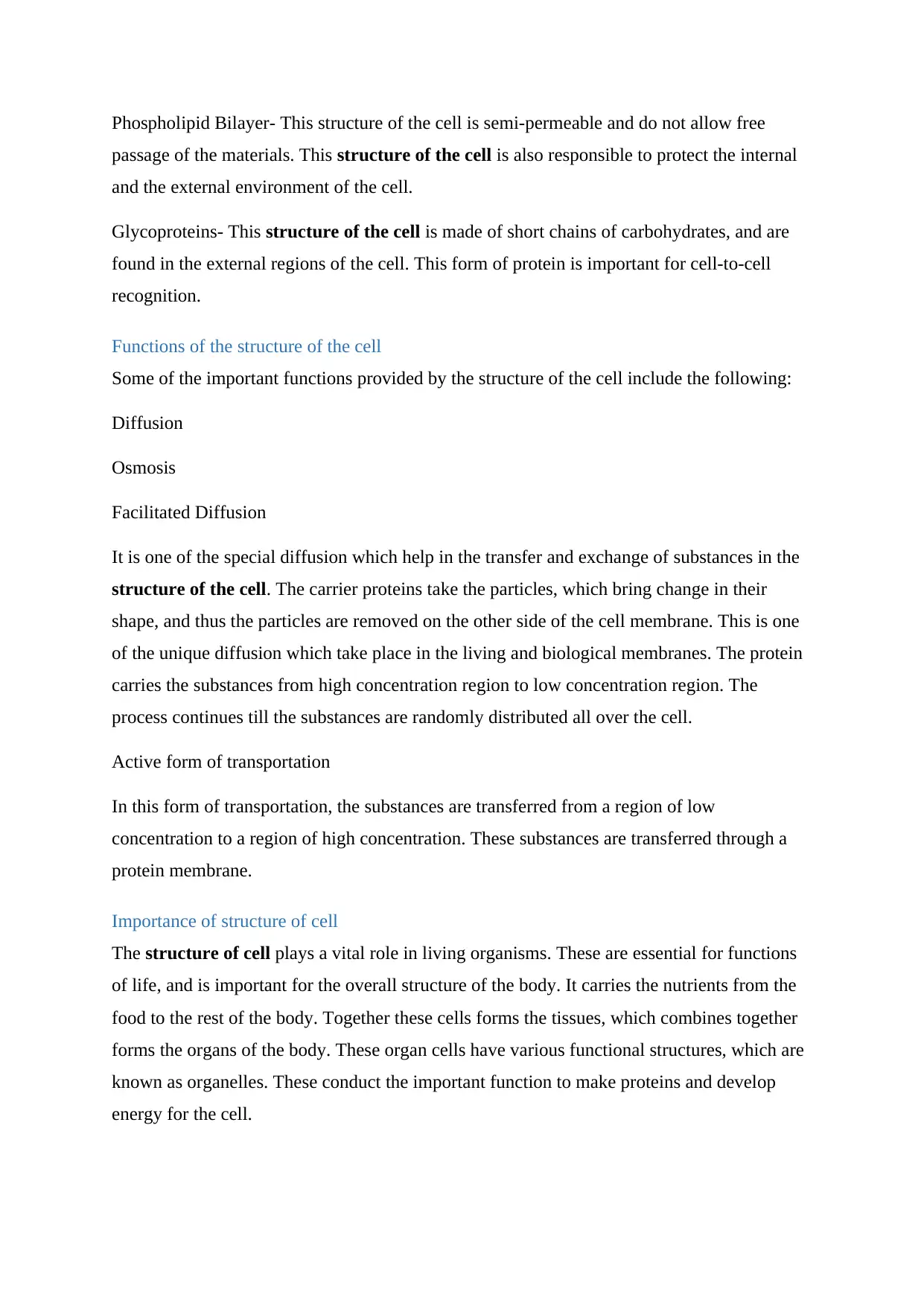
Phospholipid Bilayer- This structure of the cell is semi-permeable and do not allow free
passage of the materials. This structure of the cell is also responsible to protect the internal
and the external environment of the cell.
Glycoproteins- This structure of the cell is made of short chains of carbohydrates, and are
found in the external regions of the cell. This form of protein is important for cell-to-cell
recognition.
Functions of the structure of the cell
Some of the important functions provided by the structure of the cell include the following:
Diffusion
Osmosis
Facilitated Diffusion
It is one of the special diffusion which help in the transfer and exchange of substances in the
structure of the cell. The carrier proteins take the particles, which bring change in their
shape, and thus the particles are removed on the other side of the cell membrane. This is one
of the unique diffusion which take place in the living and biological membranes. The protein
carries the substances from high concentration region to low concentration region. The
process continues till the substances are randomly distributed all over the cell.
Active form of transportation
In this form of transportation, the substances are transferred from a region of low
concentration to a region of high concentration. These substances are transferred through a
protein membrane.
Importance of structure of cell
The structure of cell plays a vital role in living organisms. These are essential for functions
of life, and is important for the overall structure of the body. It carries the nutrients from the
food to the rest of the body. Together these cells forms the tissues, which combines together
forms the organs of the body. These organ cells have various functional structures, which are
known as organelles. These conduct the important function to make proteins and develop
energy for the cell.
passage of the materials. This structure of the cell is also responsible to protect the internal
and the external environment of the cell.
Glycoproteins- This structure of the cell is made of short chains of carbohydrates, and are
found in the external regions of the cell. This form of protein is important for cell-to-cell
recognition.
Functions of the structure of the cell
Some of the important functions provided by the structure of the cell include the following:
Diffusion
Osmosis
Facilitated Diffusion
It is one of the special diffusion which help in the transfer and exchange of substances in the
structure of the cell. The carrier proteins take the particles, which bring change in their
shape, and thus the particles are removed on the other side of the cell membrane. This is one
of the unique diffusion which take place in the living and biological membranes. The protein
carries the substances from high concentration region to low concentration region. The
process continues till the substances are randomly distributed all over the cell.
Active form of transportation
In this form of transportation, the substances are transferred from a region of low
concentration to a region of high concentration. These substances are transferred through a
protein membrane.
Importance of structure of cell
The structure of cell plays a vital role in living organisms. These are essential for functions
of life, and is important for the overall structure of the body. It carries the nutrients from the
food to the rest of the body. Together these cells forms the tissues, which combines together
forms the organs of the body. These organ cells have various functional structures, which are
known as organelles. These conduct the important function to make proteins and develop
energy for the cell.

The structure of the cell has nucleus which control all the functions of the cell and is also
known as the control room. The genome within the nucleus, also helps in the functions of the
cell.
known as the control room. The genome within the nucleus, also helps in the functions of the
cell.
1 out of 6
Related Documents
Your All-in-One AI-Powered Toolkit for Academic Success.
+13062052269
info@desklib.com
Available 24*7 on WhatsApp / Email
![[object Object]](/_next/static/media/star-bottom.7253800d.svg)
Unlock your academic potential
© 2024 | Zucol Services PVT LTD | All rights reserved.





